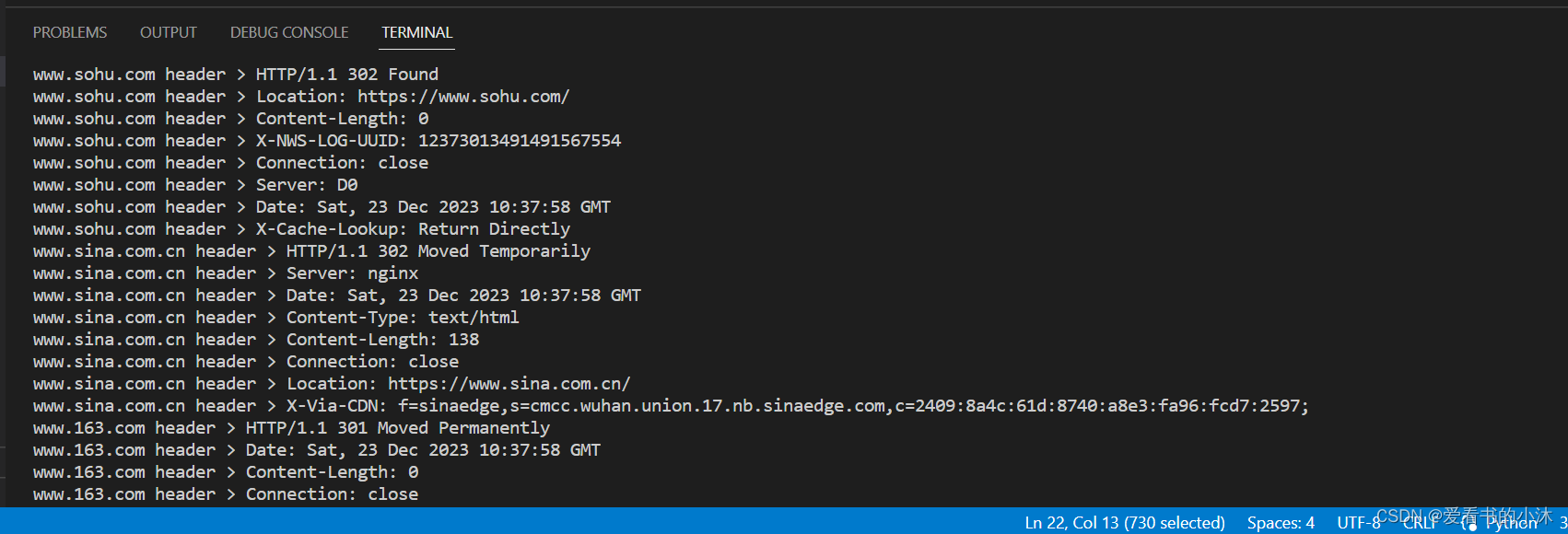文章目录
1、简介
https://github.com/aio-libs/aiohttp
https://docs.aiohttp.org/en/stable/index.html
Asynchronous HTTP client/server framework for asyncio and Python
异步 http 客户端/服务器框架


主要特点:
- 支持 HTTP 协议的客户端和服务器端。
- 支持开箱即用的客户端和服务器 Web 套接字,并避免 回调地狱。
- 为 Web 服务器提供中间件和可插拔路由。
2、下载和安装

安装库:
pip3 install aiohttp
# pip install aiodns
# pip install aiohttp[speedups]

3、代码测试
3.1 客户端
- 客户端:要从网络上获取某些内容。
import aiohttp
import asyncio
async def main():
async with aiohttp.ClientSession() as session:
async with session.get('https://www.baidu.com/') as response:
print("Status:", response.status)
print("Content-type:", response.headers['content-type'])
html = await response.text()
print("Body:", html[:15], "...")
asyncio.run(main())
运行之后:

报错了。
修改代码如下:
import aiohttp
import asyncio
async def main():
async with aiohttp.ClientSession() as session:
async with session.get('https://www.baidu.com/') as response:
print("Status:", response.status)
print("Content-type:", response.headers['content-type'])
html = await response.text()
print("Body:", html[:15], "...")
# asyncio.run(main())
loop = asyncio.get_event_loop()
loop.run_until_complete(main())
再次运行之后,没有报错。

3.2 服务端
- 服务器:使用简单服务器的示例。
# examples/server_simple.py
from aiohttp import web
async def handle(request):
name = request.match_info.get('name', "Anonymous")
text = "Hello, " + name
return web.Response(text=text)
async def wshandle(request):
ws = web.WebSocketResponse()
await ws.prepare(request)
async for msg in ws:
if msg.type == web.WSMsgType.text:
await ws.send_str("Hello, {}".format(msg.data))
elif msg.type == web.WSMsgType.binary:
await ws.send_bytes(msg.data)
elif msg.type == web.WSMsgType.close:
break
return ws
app = web.Application()
app.add_routes([web.get('/', handle),
web.get('/echo', wshandle),
web.get('/{name}', handle)])
if __name__ == '__main__':
web.run_app(app)
运行之后:

浏览器访问网址:
http://127.0.0.1:8080/


4、更多测试
4.1 asyncio
asyncio是Python 3.4版本引入的标准库,直接内置了对异步IO的支持。
asyncio的编程模型就是一个消息循环。我们从asyncio模块中直接获取一个EventLoop的引用,然后把需要执行的协程扔到EventLoop中执行,就实现了异步IO。
import asyncio
@asyncio.coroutine
def hello():
print("Hello world!111")
print("Hello world!22")
# 异步调用asyncio.sleep(1):
r = yield from asyncio.sleep(1)
print("Hello again!333")
print("Hello again!444")
# 获取EventLoop:
loop = asyncio.get_event_loop()
# 执行coroutine
loop.run_until_complete(hello())
loop.close()

import threading
import asyncio
@asyncio.coroutine
def hello():
print('Hello world! (%s)' % threading.currentThread())
yield from asyncio.sleep(1)
print('Hello again! (%s)' % threading.currentThread())
loop = asyncio.get_event_loop()
tasks = [hello(), hello()]
loop.run_until_complete(asyncio.wait(tasks))
loop.close()

import asyncio
@asyncio.coroutine
def wget(host):
print('wget %s...' % host)
connect = asyncio.open_connection(host, 80)
reader, writer = yield from connect
header = 'GET / HTTP/1.0\r\nHost: %s\r\n\r\n' % host
writer.write(header.encode('utf-8'))
yield from writer.drain()
while True:
line = yield from reader.readline()
if line == b'\r\n':
break
print('%s header > %s' % (host, line.decode('utf-8').rstrip()))
# Ignore the body, close the socket
writer.close()
loop = asyncio.get_event_loop()
tasks = [wget(host) for host in ['www.sina.com.cn', 'www.sohu.com', 'www.163.com']]
loop.run_until_complete(asyncio.wait(tasks))
loop.close()

asyncio提供了完善的异步IO支持;
异步操作需要在coroutine中通过yield from完成;
4.2 aiohttp+HTTP服务器
编写一个HTTP服务器:
import asyncio
from aiohttp import web
async def index(request):
await asyncio.sleep(0.5)
return web.Response(text='<h1>Index</h1>', content_type= 'text/html')
async def hello(request):
await asyncio.sleep(0.5)
text = '<h1>hello, %s!</h1>' % request.match_info['name']
return web.Response(text=text, content_type= 'text/html')
async def init(loop):
app = web.Application(loop=loop)
app.router.add_route('GET', '/', index)
app.router.add_route('GET', '/hello/{name}', hello)
srv = await loop.create_server(app.make_handler(), '127.0.0.1', 8000)
print('Server started at http://127.0.0.1:8000...')
return srv
loop = asyncio.get_event_loop()
loop.run_until_complete(init(loop))
loop.run_forever()


4.3 aiohttp+爬虫实例
pip install bs4
编写一个爬虫实例:
import asyncio
import aiohttp
from bs4 import BeautifulSoup
import logging
class AsnycSpider(object):
def __init__(self, url_list, max_threads):
self.urls = url_list
self.results = {
}
self.max_threads = max_threads
def __parse_results(self, url, html):
try:
soup = BeautifulSoup(html, 'html.parser')
title = soup.find('title').get_text()
except Exception as e:
raise e
if title:
self.results[url] = title
async def get_body(self, url):
async with aiohttp.ClientSession() as session:
async with session.get(url, timeout=30) as response:
assert response.status == 200
html = await response.read()
return response.url, html
async def get_results(self, url):
url, html = await self.get_body(url)
self.__parse_results(url, html)
return 'Completed'
async def handle_tasks(self, task_id, work_queue):
while not work_queue.empty():
current_url = await work_queue.get()
try:
task_status = await self.get_results(current_url)
except Exception as e:
logging.exception('Error for {}'.format(current_url), exc_info=True)
def eventloop(self):
q = asyncio.Queue()
[q.put_nowait(url) for url in self.urls]
loop = asyncio.get_event_loop()
tasks = [self.handle_tasks(task_id, q, ) for task_id in range(self.max_threads)]
loop.run_until_complete(asyncio.wait(tasks))
# loop.close()
if __name__ == '__main__':
async_example = AsnycSpider([
'https://www.qq.com/',
'https://www.163.com/',
'https://news.baidu.com/',
'https://blog.csdn.net/'], 5)
async_example.eventloop()
print(async_example.results)

4.4 aiohttp+requests比较
在 Python 众多的 HTTP 客户端中,有这几个:requests、aiohttp和httpx。在不借助其他第三方库的情况下,requests只能发送同步请求;aiohttp只能发送异步请求;httpx既能发送同步请求,又能发送异步请求。
pip install requests
- test_requests.py
import random
import time
import datetime
import requests
def make_request(session):
resp = session.get('http://httpbin.org/get')
# result = resp.text
# print(result)
pass
def main():
session = requests.Session()
start = time.time()
for _ in range(100):
make_request(session)
end = time.time()
print(f'发送100次请求,耗时:{
end - start}')
if __name__ == '__main__':
main()

- test_aiohttp.py
import aiohttp
import random
import datetime
import asyncio
import time
async def request(client):
async with client.get('http://httpbin.org/get') as resp:
# print(resp.status)
# print(await resp.text())
pass
async def main():
async with aiohttp.ClientSession() as client:
start = time.time()
task_list = []
for _ in range(100):
req = request(client)
task = asyncio.create_task(req)
task_list.append(task)
await asyncio.gather(*task_list)
end = time.time()
print(f'发送100次请求,耗时:{
end - start}')
asyncio.run(main())

结语
如果您觉得该方法或代码有一点点用处,可以给作者点个赞,或打赏杯咖啡;╮( ̄▽ ̄)╭
如果您感觉方法或代码不咋地//(ㄒoㄒ)//,就在评论处留言,作者继续改进;o_O???
如果您需要相关功能的代码定制化开发,可以留言私信作者;(✿◡‿◡)
感谢各位大佬童鞋们的支持!( ´ ▽´ )ノ ( ´ ▽´)っ!!!